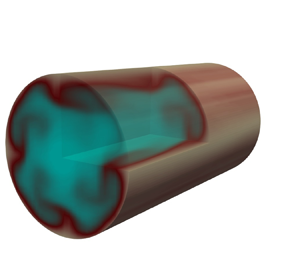No CrossRef data available.
Article contents
Data-driven state-space and Koopman operator models of coherent state dynamics on invariant manifolds
Published online by Cambridge University Press: 12 April 2024
Abstract

The accurate simulation of complex dynamics in fluid flows demands a substantial number of degrees of freedom, i.e. a high-dimensional state space. Nevertheless, the swift attenuation of small-scale perturbations due to viscous diffusion permits in principle the representation of these flows using a significantly reduced dimensionality. Over time, the dynamics of such flows evolves towards a finite-dimensional invariant manifold. Using only data from direct numerical simulations, in the present work we identify the manifold and determine evolution equations for the dynamics on it. We use an advanced autoencoder framework to automatically estimate the intrinsic dimension of the manifold and provide an orthogonal coordinate system. Then, we learn the dynamics by determining an equation on the manifold by using both a function-space approach (approximating the Koopman operator) and a state-space approach (approximating the vector field on the manifold). We apply this method to exact coherent states for Kolmogorov flow and minimal flow unit pipe flow. Fully resolved simulations for these cases require  $O(10^3)$ and
$O(10^3)$ and  $O(10^5)$ degrees of freedom, respectively, and we build models with two or three degrees of freedom that faithfully capture the dynamics of these flows. For these examples, both the state-space and function-space time evaluations provide highly accurate predictions of the long-time dynamics in manifold coordinates.
$O(10^5)$ degrees of freedom, respectively, and we build models with two or three degrees of freedom that faithfully capture the dynamics of these flows. For these examples, both the state-space and function-space time evaluations provide highly accurate predictions of the long-time dynamics in manifold coordinates.
JFM classification
- Type
- JFM Rapids
- Information
- Copyright
- © The Author(s), 2024. Published by Cambridge University Press





